
 |
Eager Space | Videos by Alpha | Videos by Date | All Video Text | Support | Community | About |
|---|

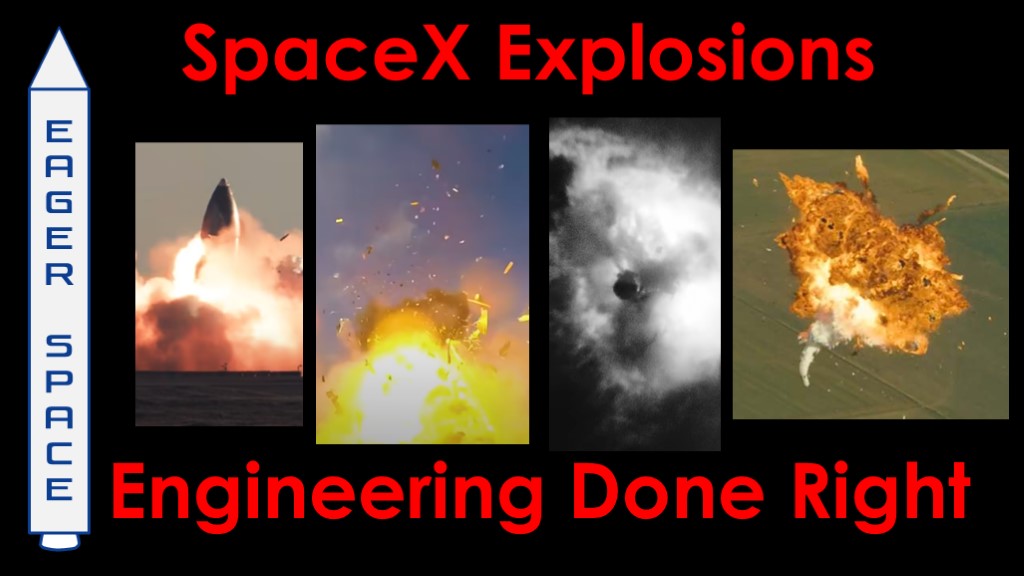
https://library.sciencemadness.org/library/books/ignition.pdf
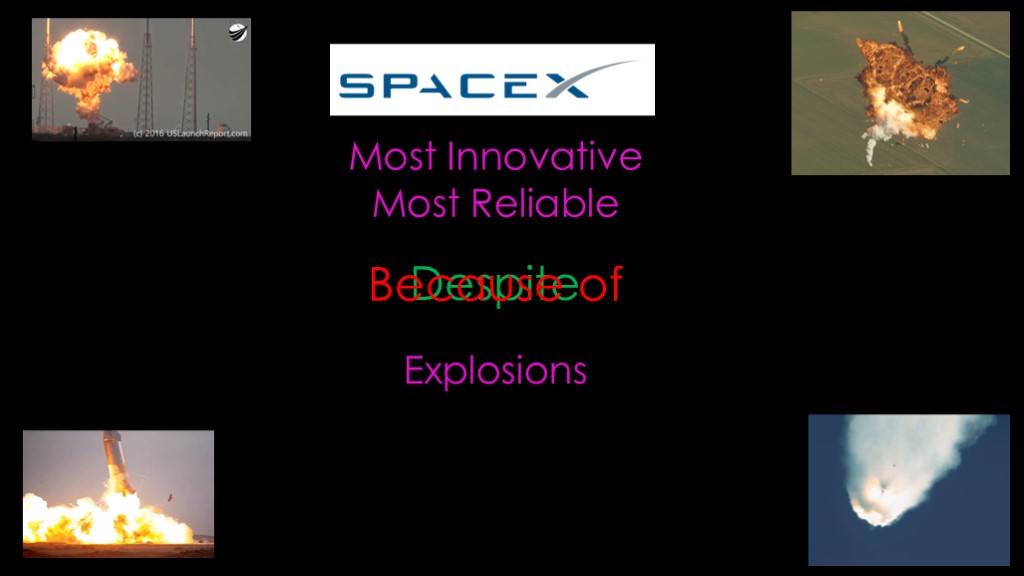
If you follow SpaceX, you've seen explosions. Quite a few explosions. That presents us with a bit of a puzzle.
SpaceX is generally considered the most innovative space company in the world and Falcon 9 is likely the most reliable launcher in the business, with 261 successes since their last failure.
And yet, explosions.
Somehow, SpaceX ends up being the most innovative and most reliable company despite the explosions...
But the truth is a bit stranger than that. SpaceX is the most innovative and reliable company because of the explosions.
To understand why this is the case will require a bit of an explanation...

It is helpful to categorize SpaceX programs by their explosiveness.
Cargo dragon had no explosions, nor has the beefy Falcon Heavy. I'm going to ignore any issues from Falcon Heavy booster recovery.
The failure of the first Falcon 1 flight involved an engine fire and crashing into the ground, and I'm going to label that an explosion.
Falcon 9 has blown up twice. Once when a strut holding a helium pressurization tank in the second stage broke and overpressurized the oxygen tank. Not a fire explosion, but still an explosion.
And once during fueling due to a different problem with the helium pressurization tanks.
A crew dragon blew up in an uncrewed test of the abort propulsion system. These three systems were slightly explosive.
Which leaves us with two more projects...
By my count, there were 8 explosions during the development of reuse for the Falcon 9, as chronicaled in SpaceX's wonderful video, "How not to land an orbital class booster".
Starship has also brought us a significant number of explosions.
Why are Falcon 9 reuse and starship different from the other projects? Why are they so much more explody?
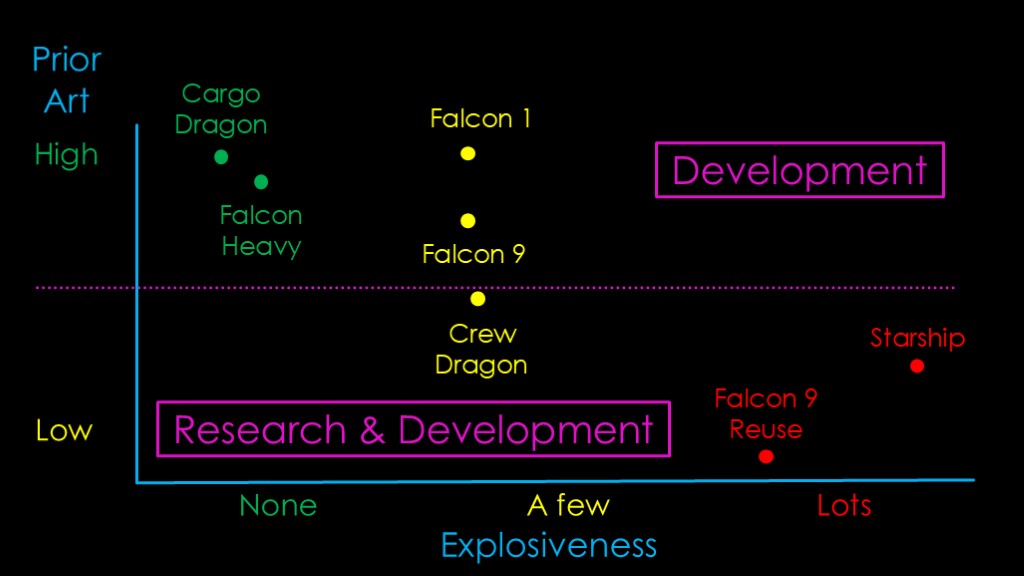
I'm going to add another dimension to our chart, one that I'm going to label "prior art".
Prior art refers to any previous projects/programs/research that has been done in a specific area. Are you doing something that has been done many times, or are you breaking new ground? Are there books on what you are trying to accomplish, or NASA technical reports?
Cargo dragon was new to SpaceX, but satellites that need to navigate in orbit have been around for decades and they are very well understood. Falcon Heavy was based on the Falcon 9 which was very well understood, and there are other examples of clustered boosters in rocket history.
Falcon 1 had a lot of prior art in previous launch systems. Falcon 9 could build on Falcon 1 - the Merlin 1c engine came directly from Falcon 1 - and other rockets had used clusters of engines, though 9 was a large number.
Crew Dragon benefitted from Cargo Dragon and all the NASA legacy of crewed capsules, but there was a fair amount of new work due to SpaceX's choice of capsule shape, abort approach, and parachute architecture.
My guess is that you have figured out where this is going...
Falcon 9 reuse had very little prior art. Nobody had ever tried to land an orbital booster.
Starship has some prior art - falcon 9 has given SpaceX a lot of useful information, and you can look at shuttle and NASA for information on thermal protection tiles - but Starship has a ton of new stuff that has never been done before plus an innovative new engine using an uncommon fuel.
I'm going to draw an arbitrary line separating the groups of projects. For the top group, SpaceX was primarily doing development work - applying existing approaches to a specific problem.
For the bottom group, SpaceX was doing research and development - they had to figure out how to do new things, things that had never been done before. There were no existing approaches.
My assertion is that research and development is generally more explody - at least it is if you are doing it right.
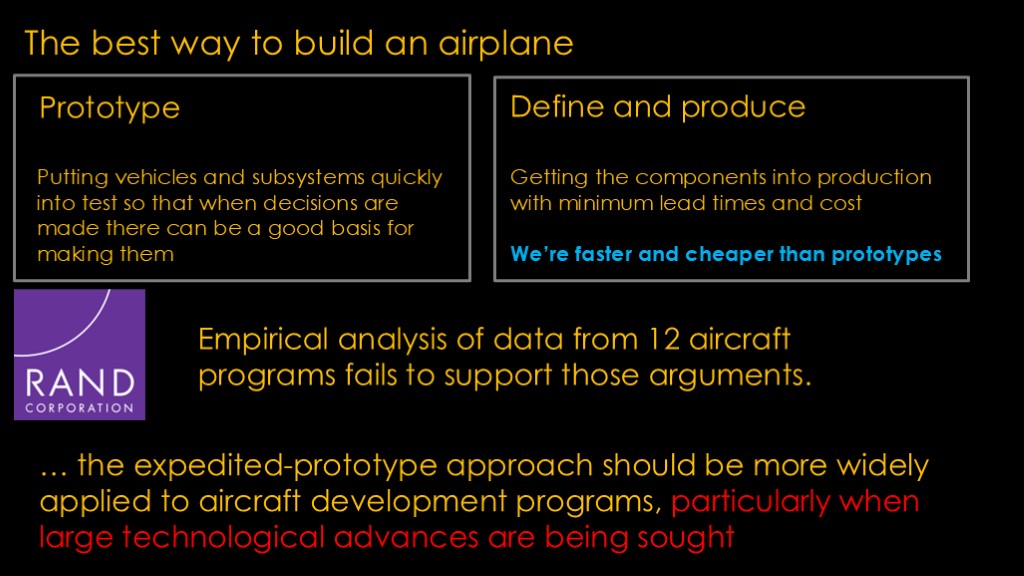
It's pretty common to feel good when you come up with an insight, and it's also pretty common to find out that your insight is neither new nor original.
Back in the 1960s there was an ongoing debate about the best way to build an airplane, and by best they meant "cheapest and fastest".
There were two schools at odds with each other. The prototype folks said that you should build a prototype of the airplane so that you had actual data to feed into decisions.
The "define and produce" folks - sometimes known as the "development production" folks - said that you should do your design and definition up front and focus on starting production early. They asserted that define and produce was both faster and cheaper than prototypes - prototypes are just a waste of time and money.
The air force thought it would be very useful to know which approach was better because they bought a lot of new planes, so they commissioned the rand corporation to do a study that examined the question. Rand looked at 12 aircraft projects and concluded that their analysis did not support the assertion that the define and produce approach is faster and cheaper.
They went beyond that, and concluded that (read)
Using prototypes was considered the better way to do the things with low amounts of prior art, all the way back in the early 1970s.
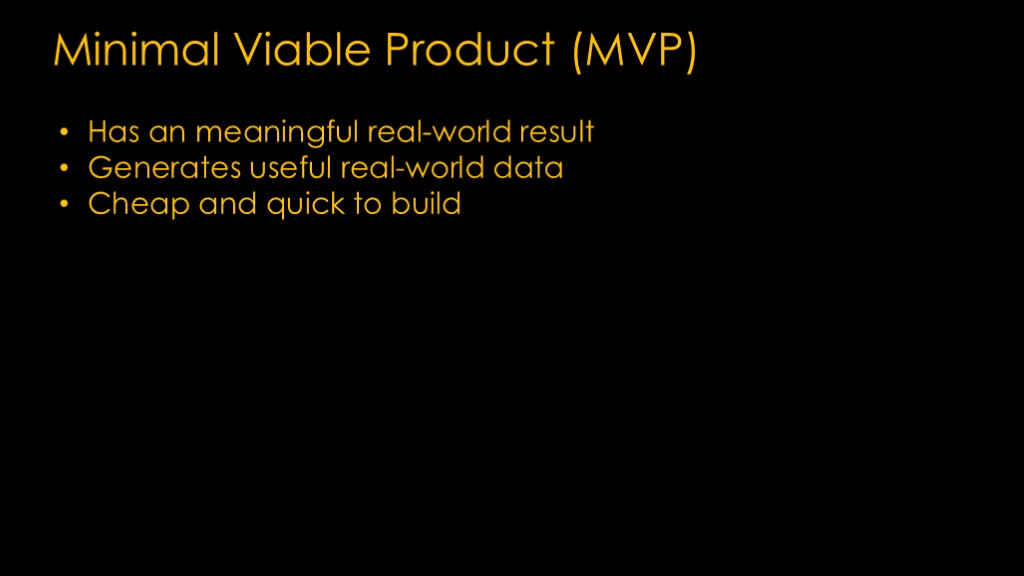
If you are going to build a prototype, you need to decide what that prototype will actually do.
I believe that SpaceX is using a concept that is common in the software world, a concept known as minimal viable product, or MVP
The point is to choose a goal that meets a short set of constraints.
First, it has to have a meaningful real-world result, one that you can easily demo to people outside the team.
Second, it has to generate useful real-world data.
Third, it needs to be cheap and quick to build.
The point is to be incremental. Without prior art we aren't exactly sure where we are going so we limit ourselves to something that we know we will need that takes a step in the next direction.
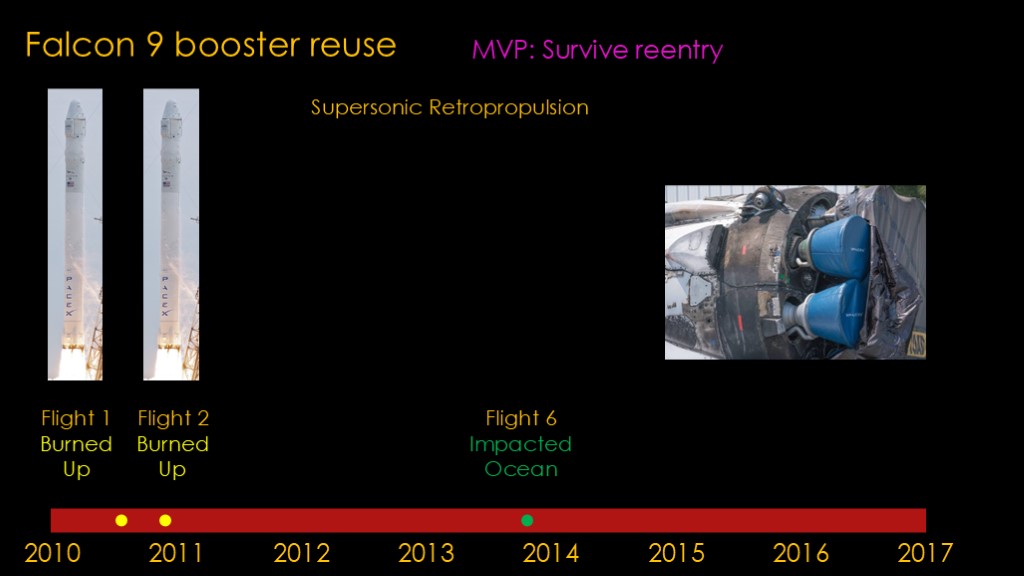
For Falcon 9 booster reuse, SpaceX had an interesting opportunity. They were already going to be flying Falcon 9 rockets, and any flight that could carry the extra weight of their recovery equipment became a potential flight test.
Their first MVP was something like "survive reentry".
SpaceX put parachutes on the very first launch of Falcon 9 in June of 2010. The booster burned up on reentry before the parachutes got to deploy.
They tried again with the second launch in December of 2010, with the same result.
That was not going to work.
They were distracted for a while by the creation of Falcon 9 Version 1.1, but that new version gave them more mass to devote to reuse, and they came up with a new plan.
First, they added heat shielding around the engines of the booster, and second, they came up with the idea of running the engines during reentry to both slow the booster down and to push the reentry heat away. They called it supersonic retropropulsion, and it looks like this.
That flew on flight 6 of Falcon 9, and they successfully made it through reentry on their first try with this method, even though the booster impacted the ocean hard. They had achieved their first MVP - they knew how to survive reentry.
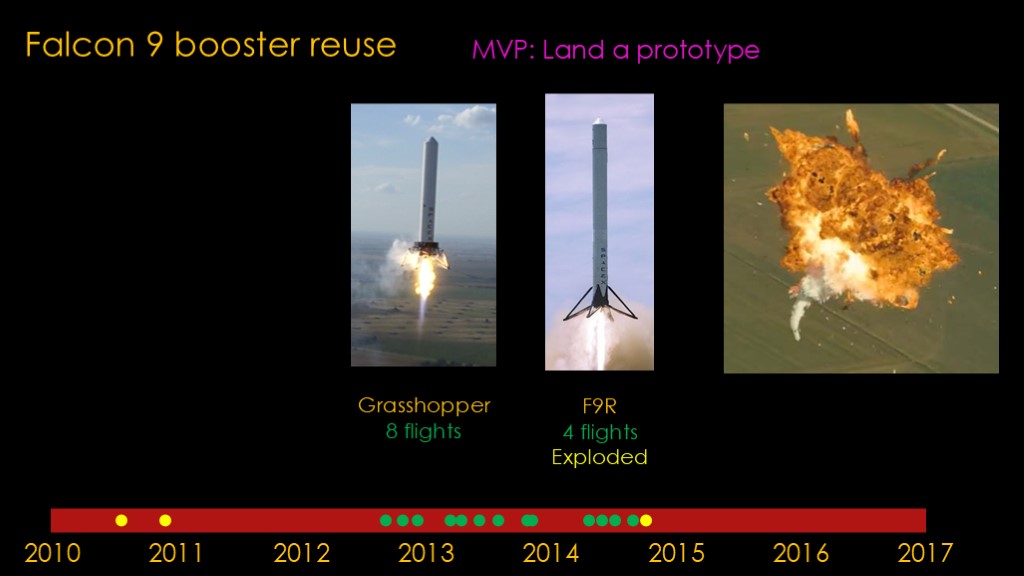
At the same time, they were working on different MVP- how to land a booster softly.
They built a prototype out of a Falcon 9 Version 1 first stage and a single Merlin engine and named it grasshopper. It made 8 flights, all successful.
Grasshopper was followed by F9R, built on a Falcon 9 version 1.1 first stage. It featured deployable legs and looks much more like the first stage we are used to seeing. It flew four successful flights, but on the 5th flight a blocked sensor caused the flight path to deviate and the prototype was destroyed by the flight termination system.
SpaceX had planned a third prototype for high altitude testing but decided that they had learned enough to be confident in their approach. The landing prototype stage was done.
SpaceX count get through reentry and they knew a lot about low speed control and landing. What they needed to do is hook those two together, and most of their launches provided an opportunity to try to do just that. They could afford to build lots of prototypes.
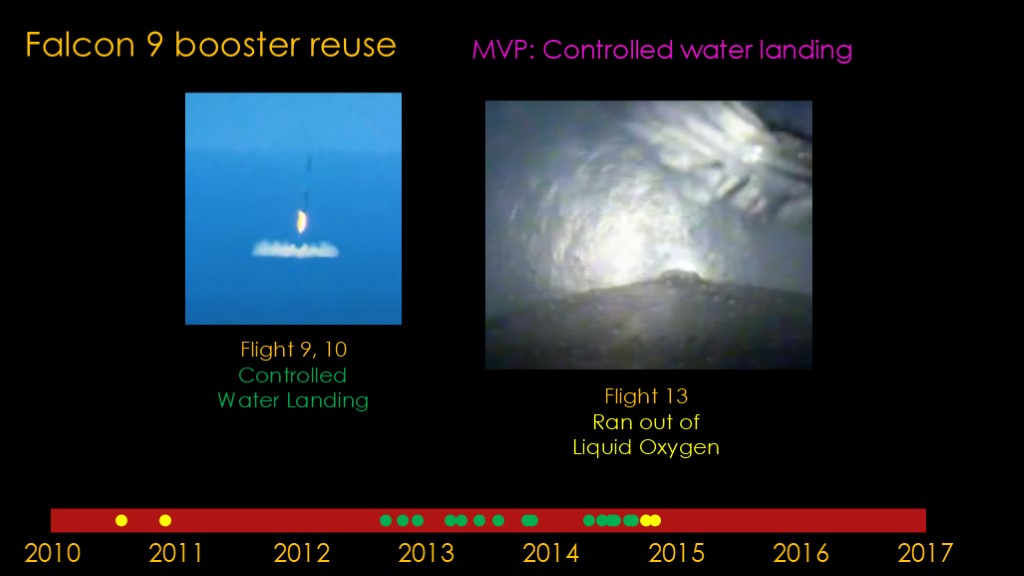
The first MVP was going from reentry to a controlled water landing.
Their next two attempts were successful; flights 9 and 10 were successful at achieving a controlled landing in the water.
Flight 13 was their next attempt and the booster ran out of liquid oxygen.
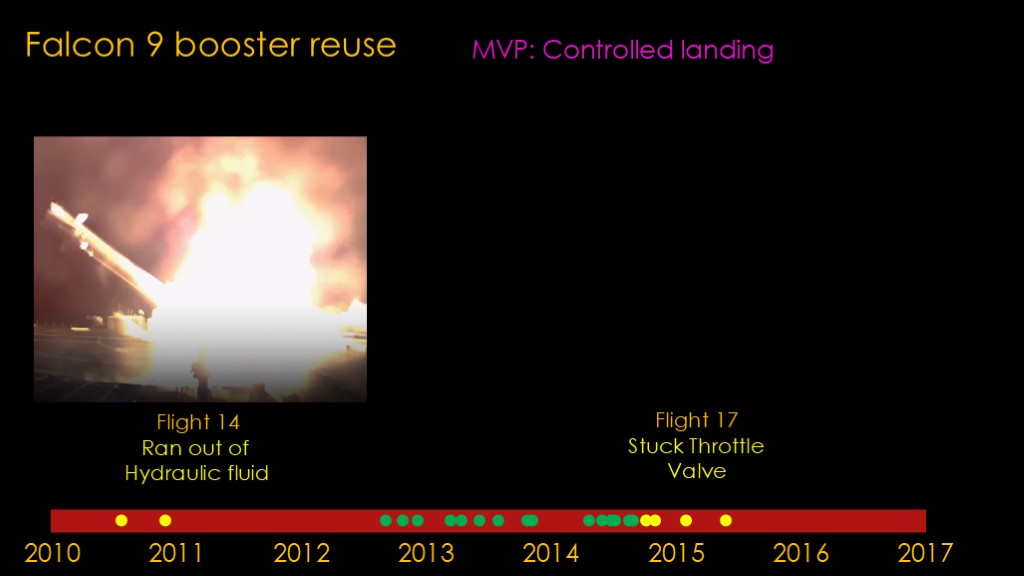
Flight 14 was the first flight of their grid fin control system that would allow them to precisely control their landing point, but it ran out of hydraulic fluid.
Flight 17 had a stuck throttle valve.
(watch video).
It seemed that SpaceX was coming up with lots of ways to crash their rocket.
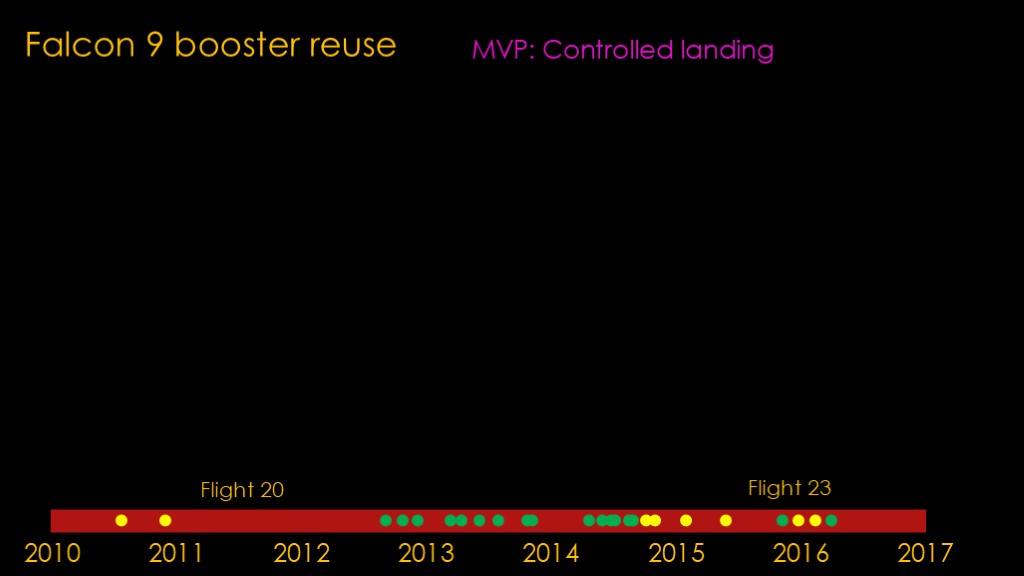
After a few more tests, we finally saw this - a successful landing on land, followed by a successful landing on the drone ship.
It was impressive, but they had 6 failures and only two landing successes.
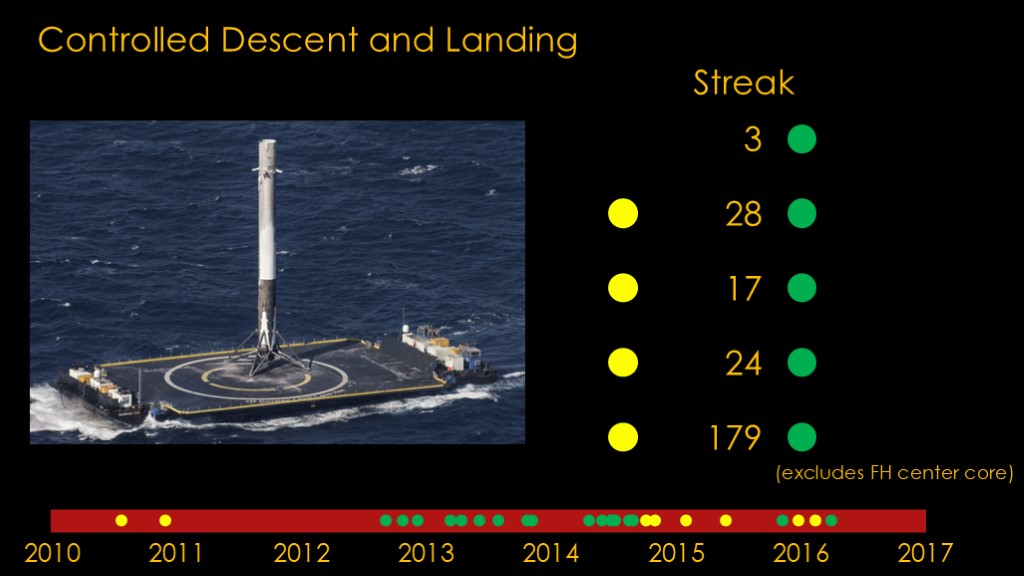
And then something happened that surprised most of us.
SpaceX landed two more missions, getting to three in a row.
One failure due to low engine thrust, then 28 in a row.
A failure due to a grid fin issue, then 17 in a row.
A failure due to incorrect wind data, then 24 in a row.
During this section, SpaceX landed 69 out of 72 attempts, for a 96% success rate. Which is far higher than pretty much anybody had forecast.
One last failure due to an engine issue on ascent - technically not even a landing failure - and that takes us to the current string of 179 successful landings, which is astonishing.
What we hadn't realized was that every failure led to a modification in the hardware, the software, or the process. They worked through virtually all the ways to fail and once they had, the system was incredibly robust.
It was their flexibility in treating every flight as a prototype they could learn from rather than trying to design things up front that took them from successfully getting through the atmosphere to landing both on land and on the drone ship in less than 3 years.
And it also resulted in a design with the minimal impact on payload because they didn't add systems they didn't need.

(keep?)
There was another time that there were lots of rockets blowing up.
That was in the 1950s, when rockets were new and therefore any new rocket was a research program.
That made them quite explody. Those sorts of failures are much less common today, and when they do occur, they are generally related to engines, which still require a lot of research.
There's one other program that comes to mind...
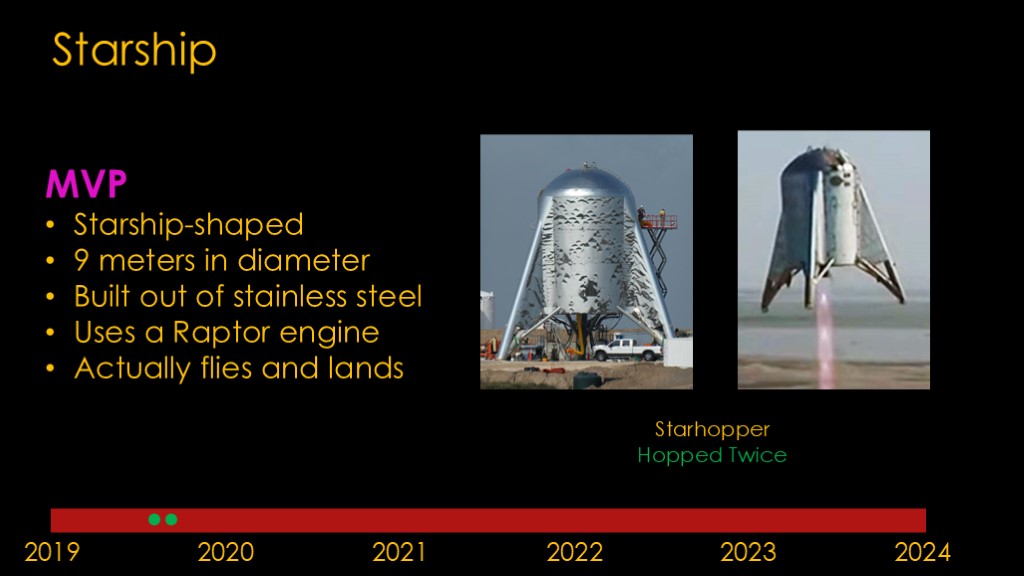
Which takes us to starship.
At the start of Starship, SpaceX had a grand vision but little hardware. Here's what I think their first minimal viable product was:
It needed to be shaped like the final product would be.
It needed to be the final diameter - 9 meters - because the ground support infrastructure would need to support that diameter
It needed to be build out of stainless steel, the material choice for the final product
It needed to use a raptor engine
And finally, it needed to actually fly and land, so that others could see that it did what it was supposed to do.
Those requirements drove a bunch of other requirements - you need a working engine, you need delivery of liquid methane and oxygen, you need a test area, and you need to get approval from the FAA to fly the thing. And you need to deliver finished work that actually functions well enough for your tests.
The vehicle SpaceX created came to be known as Starhopper. It was an ugly brute, made out of ½" steel that was 3 times the thickness of later vehicles and hand-welded, but it flew and it flew well, with two flights in July and August of 2019. Their success should not have been a big surprise as the technical challenge for starhopper was low.
SpaceX learned a ton about everything starship, from how the Raptor engine worked to how to work with the FAA to how to integrate systems. And it allowed them to start the project with an obvious success.
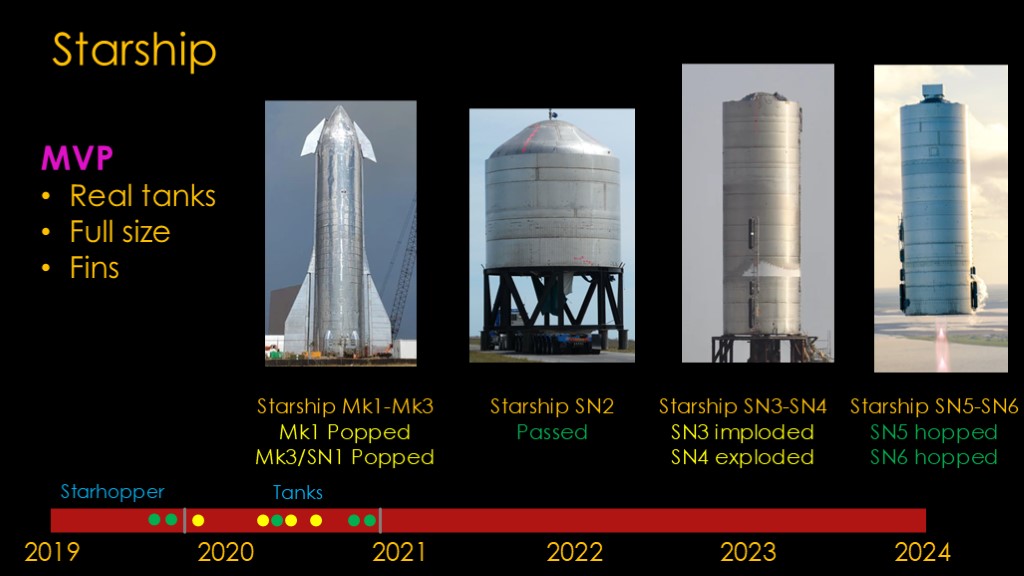
Once you have minimal viable product finished, you work on the next one by adding things that make it more real. The next MVP would move to real tanks made out of thinner stainless steel, a full size vehicle, and fins while still doing everything that starhopper had done.
Mark 1 and Mark 2 came next, with one developed in Texas and one in Florida. Mark 1 popped during pressure testing and Mark 2 was abandoned. Mark 3 (aka SN1) popped during pressure testing.
Tanks were clearly harder than expected. SpaceX stopped doing the fin work and converted SN2 to a pure tank test, which passed. They went back to full-sized tanks.
SN3 imploded when the oxygen tank was depressurized. SN4 exploded after a static fire due to a failure in the quick disconnect system. Tanks were getting better but the ground support equipment still needed work.
Finally Starship SN5 passed all the tests and hopped, and soon after, SN6 did the same.
During this time, SpaceX was doing research on how to build and operate the tanks. It took a few tries, but they learned enough so that tank construction is no longer an issue. They had use the "many prototypes" approach to both understand how to build tanks and to build enough of a factory to be able to build prototypes cheaply, and it took them roughly a year to get to where they wanted to be.
This phase was really all about the factory and the ground equipment development; the two hops didn't do anything beyond what Starhopper had done.

We can make an interesting comparison of SpaceX's approach to another approach.
ULA has been working on their Vulcan Centaur rocket for a number of years. Vulcan marries a booster with BE-4 engines from Blue Origin with a new Centaur V upper stage, much bigger than the previous Centaur III upper stage and with thinner walls.
In March of 2023, they were doing a test to qualify the Centaur upper stage for all missions. This test would generally be considered a formality - merely a box to check on the way to launching a new rocket.
But a hydrogen leak led to an explosion that destroyed the stage and caused significant damage to the test stand. Subsequent analysis found higher loads in the tank than expected and weaker welds than expected.
It's not clear how much analysis and testing ULA had done on the new tanks, but it is clear that they didn't catch this issue early, and the subsequent redesign resulted in a delay of around 6 months.
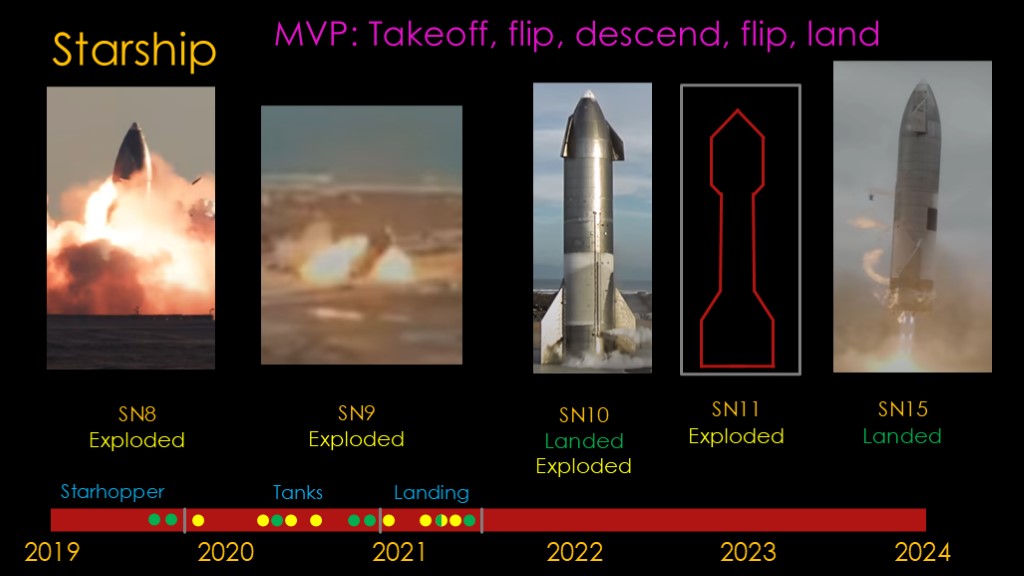
The next MVP covers the landing segment of a starship mission. It is to takeoff, flip horizontally, control the vehicle during descent, flip back, and land.
The controlled descent seems straightforward, but restarting engines and then flipping right before landing has no prior art, so we would expect it to be challenging, and therefore... you guessed, explody.
SN8 took off on three engines, climbed to 12,500 meters, flipped sideways and fell back to ground under control, but crashed into the ground due to a propellant pressure issue.
SN9 was a repeat of SN8, crashing into the ground because of engine issues.
SN10 landed successfully, but the landing was a hard one and it exploded a few minutes after landing, so we can only give partial credit for that one.
SN11 is a bit of an enigma. It flew in heavy fog, descended, and exploded either near the ground or crashing into the ground.
SN12-14 were abandoned to go with SN15, a improved design based on the four previous flights.
SN15 landed successfully. Completing this MVP had taken 5 vehicles and was completed in less than 6 months.
People often ask why SpaceX didn't fly more of these flights. One reason is that they had all the data they needed and knew how to do it successfully - they had completed their MVP. A second reason is that they would be doing landing after reentry tests on future MVPs and those would give them ample opportunity to test descent and landing under real flight conditions.
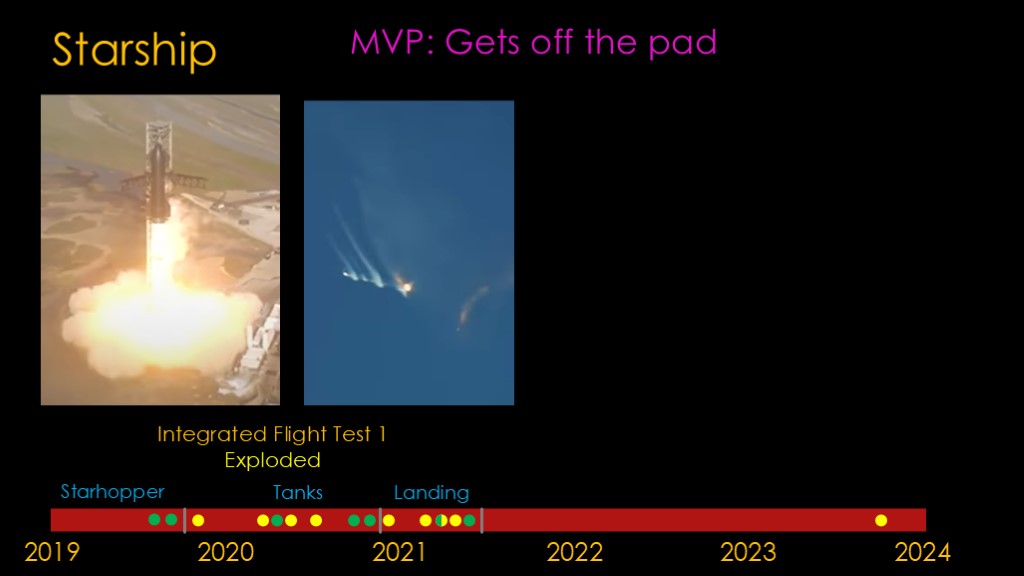
The next phase involves the whole vehicle. There are a lot of new things here and the booster is an order of magnitude higher in thrust than starship tests. If you look at what SpaceX said before and after this test, I think the MVP was "gets off the pad". They planned in case everything worked right with water landings of super heavy and an orbital reentry of starship, but I don't think they really expected to get that far - their goal was "get a ton of data" and feed that data into the next prototype.
This test did not disappoint, it did get off the pad and make it kindof near staging but it seriously damaged the pad and the vehicle couldn't even blow itself up properly.
This flight frankly confused a lot of people, who expected something like the early flights of Falcon 9, which all worked great. Falcon 9 had lots of prior art and SpaceX was focusing on just getting to orbit, while starship is mostly new stuff and SpaceX is optimizing from the start. Many people suggested that SpaceX was failing, or that they should have done a lot more work before this launch.
I mostly disagree - they are building these prototypes to fly them and even if they aren't going to be perfect their way of developing starship involves a lot of imperfect prototypes. We've already seen the power of that approach with Falcon 9 landing development and the earlier starship MVPs.
Though I think in retrospect they should have done flame diverter work before the launch and I'm pretty sure SpaceX would agree with that.
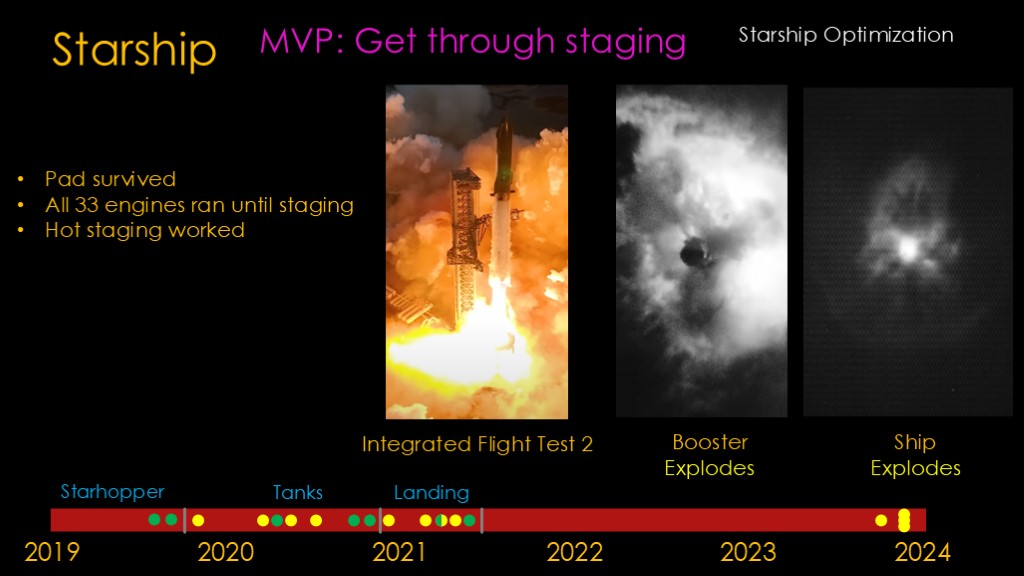
Integrated flight test 2 was up next, and I think the MVP this time was "get through staging".
To add to the fun, SpaceX modified their staging approach to add "hot staging" - starting the second stage while the first stage engines were still running. There is some good prior art with hot staging - the Titan II rocket used it, as did the Russian Proton.
The big challenge on this flight was what happened after staging. As I talked about in my starship optimization video, the booster will by flying back to the launch site as quickly as possible to use as little propellant as possible, and that means a quick turn around. And this is also the first flight of Starship into vacuum and the first flight of the Raptor Vacuum engines.
The initial part of the flight was great, and hot staging worked.
Soon after staging, the booster started the flip maneuver to head back to the launch site and soon after that it exploded. This harkens back to the early explosions during testing of the starship flip maneuver.
Starship continued on, nearly reaching orbital velocity before it too exploded, marking this as the first time SpaceX has achieved two explosions in a single test.
It's tempting to view this as another failure, but it shows amazing progress over the first flight. The pad survived, all 33 engines worked through staging, and hot stating worked. The ultimate explosions appear to have been triggered by the automatic flight termination system when the vehicle was not on the expected trajectory.
We would all like to see the booster do a controlled water landing, but at this point in the research program figuring out how to do the new optimized boost back is much higher priority than doing the already-well-understood booster landing.

Going forward, SpaceX still has some big new things to make work, and because they are new things, there's a decent chance that some of them will be explody.
But my bold prediction is that Starship is going to follow the same pattern as Falcon 9 reuse. We'll see more failures before we see full success, but soon after that starship is going to start working pretty much every time and we'll all be wondering why we didn't see this ahead of time.
Explosions are good. Learn it. Know it. Live it.
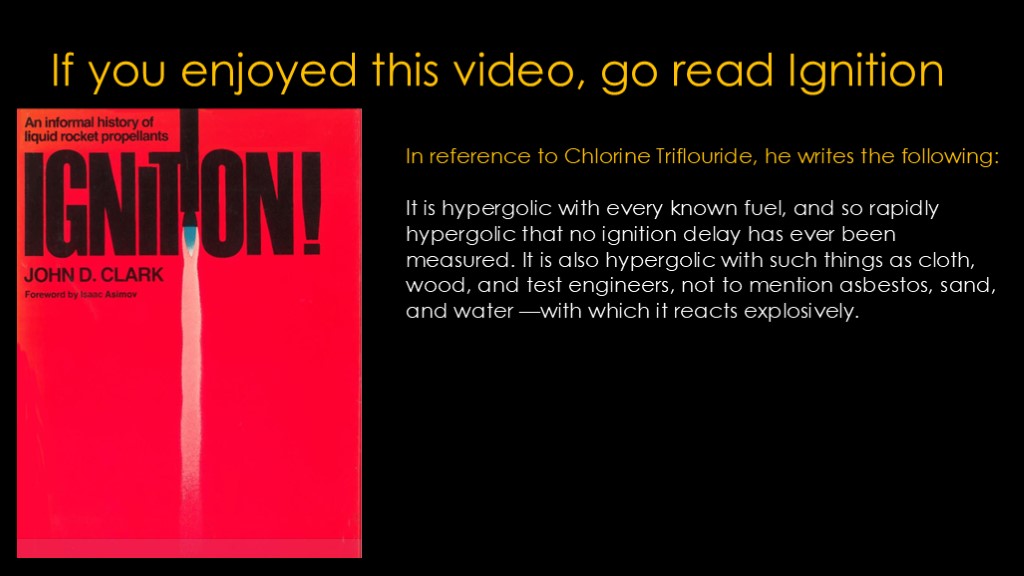
If you enjoyed, this video, I suggest you go read John D. Clark's classic book, "Ignition - an informal history of liquid rocket propellants". You can read online for free. I'll put a link in the description.
In reference to chlorine Triflouride, he writes the following: (read)
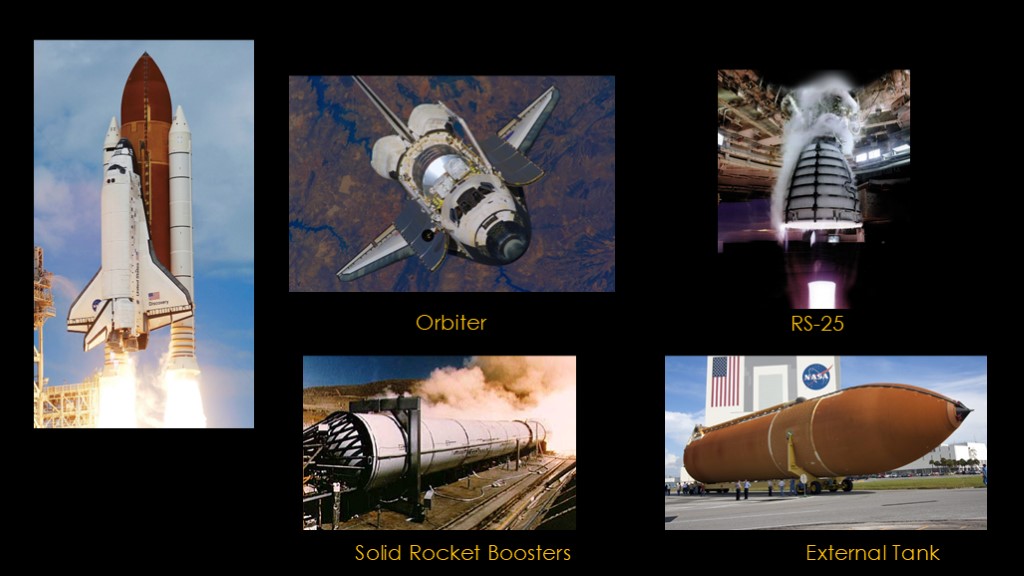
And that's the space shuttle. Shuttle was full of new technology, including the high performance RS-25 engine, the external tank, the solid rocket boosters, and the very complex orbiter.
One can make a fair argument that shuttle is similar in challenge to Starship and it's interesting to look at how NASA ran the program.

Here's the timeline
The shuttle program officially started in 1972. In 1977 the test shuttle Enterprise flew a short series of 5 flight tests to evaluate the low speed performance of the orbiter. The word "prototype" is sometime used to describe enterprise, but enterprise was not a prototype as it could not be tested on actual shuttle missions
Then in 1981, STS-1 marked the first test flight. There were a few unexpected issues that could have been significant - see my video "the near tragedy of STS-1" - but NASA got lucky and fixing the issues was relatively straightforward.
They flew three more test flights and in 1982 declared the shuttle operational.
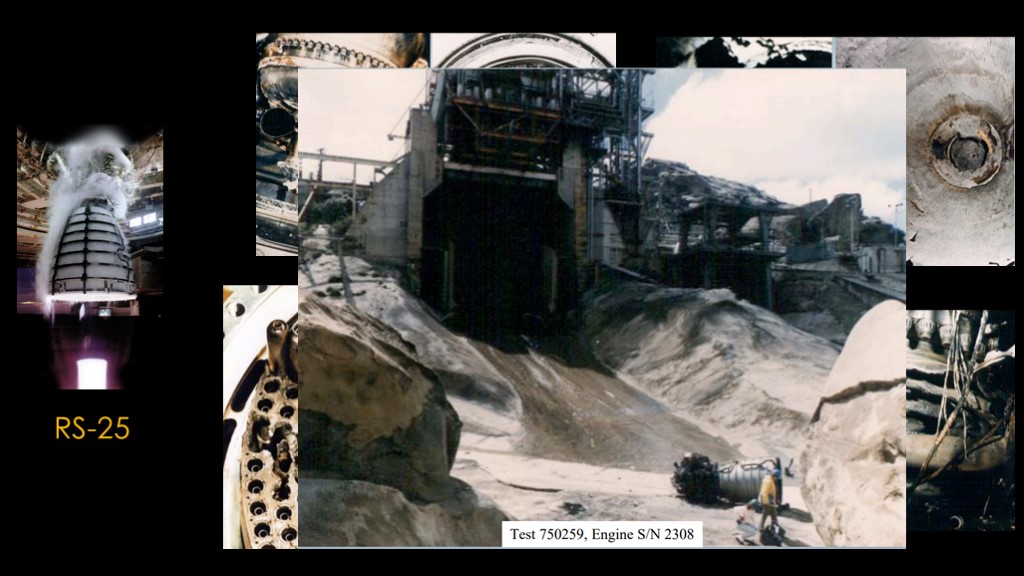
The RS-25 main engines were considered to be a very challenging design, and NASA specified that they must undergo at least 65,000 seconds of testing before the first flight. The actually achieved over 110,000 seconds of testing.
As is typical of engine development, there were many failures during testing, and most of them were explosive. I'm particularly fond of this post-test picture.
But all of that testing allowed Rocketdyne to develop an engine that was one of the most robust parts of shuttle, with only one failure in flight and just a handful of failures on the pad.
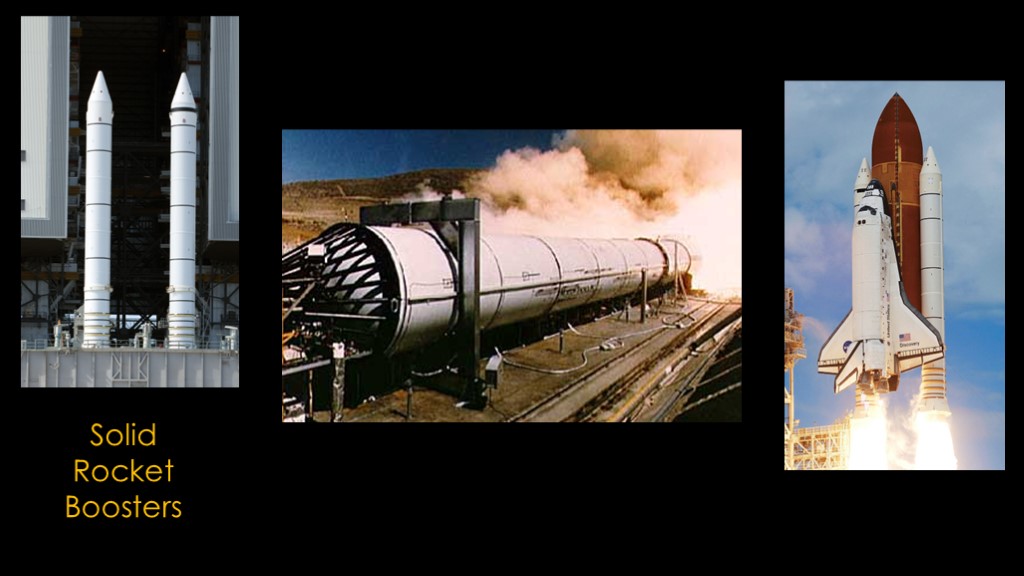
The solid rocket boosters were a larger version of a new technology, and they were well designed with accepted practices and tested.
Unfortunately, in actual flight the solid rockets bend and vibrate in response to aerodynamic loads on the whole stack, and the seals between segments did not perform properly in that scenario, and that ultimately led to the loss of Challenger.
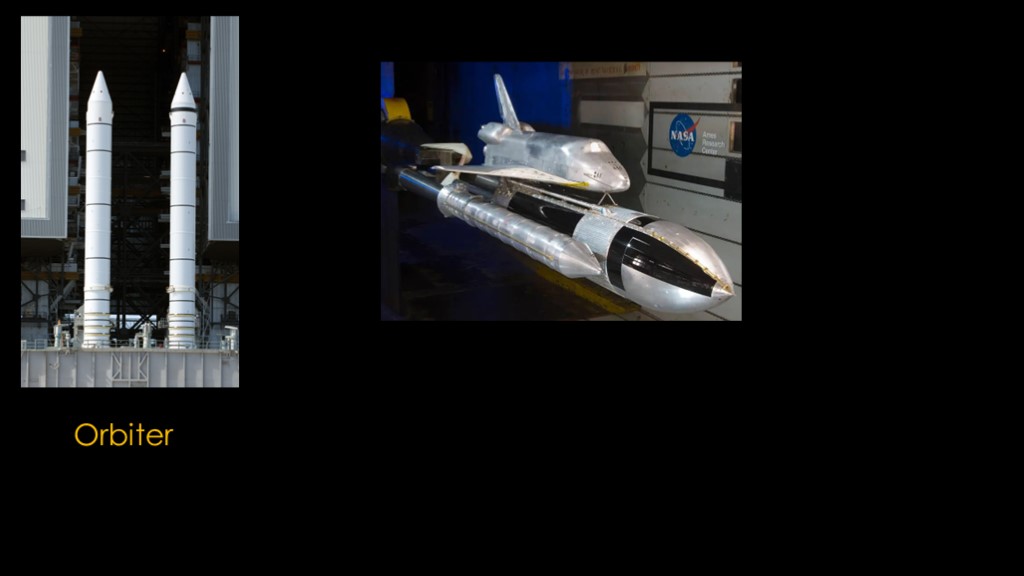
27,000 hours of wind tunnel testing.
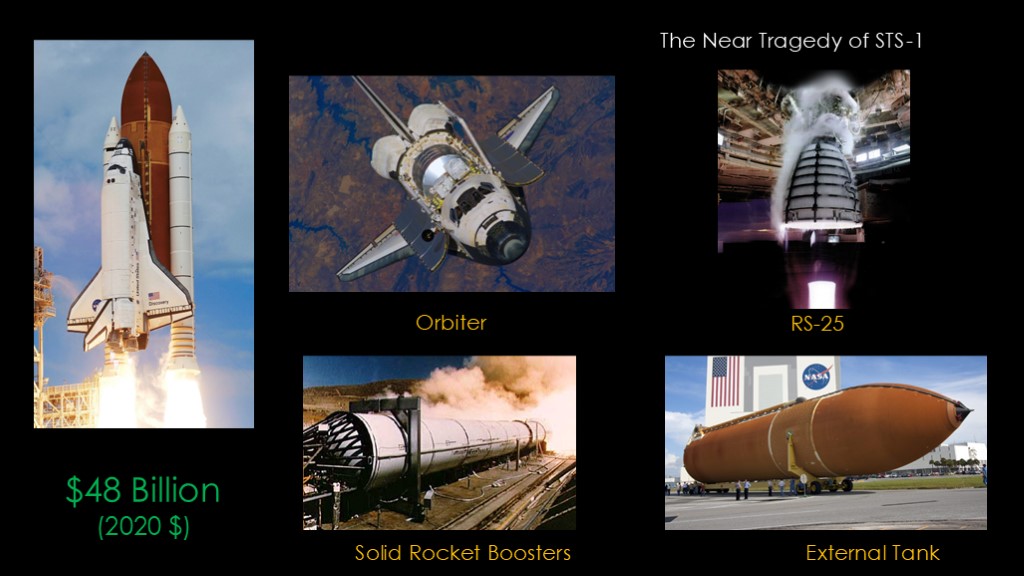
(redo this, split apart)
And that's the space shuttle. Shuttle was full of new technology, including the high performance RS-25 engine, the external tank, the solid rocket boosters, and the very complex orbiter.
NASA started development work on shuttle in 1972 and spent about 9 years in design, analysis, and construction. Shuttle cost about $48 billion in 2020 dollars to get to its first flight.
At this point, NASA had a problem. They were committed to building 4 orbiters with their initial, unflown design, and committed to putting astronauts on that first flight.
That flight was thankfully successful, but it could have gone differently - see "the near tragedy of STS-1".
NASA was left with 4 experimental orbiters that they needed to fly a lot of missions on and a very limited ability to fix issues that cropped up. That is one of the downsides of trying to do innovative things without sufficient real-world testing, and it ended up being one of the reasons for the Challenger and Columbia accidents. NASA had an orbiter that had ongoing issues but needed to fly it as if it was a finished production vehicle.
Shuttle is an indication that you can get rid of some of the explody issues through analysis but some still crop up during flight, and you would much prefer that they come up during test flights.